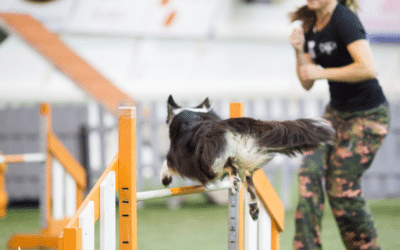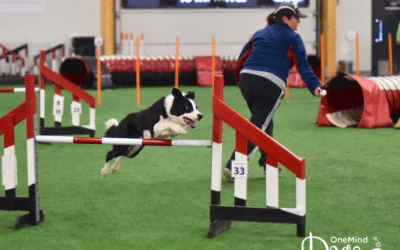Are you dreaming of perfect contact performance in your dog agility training? If so, you’ve come to the right place! In dog agility, contacts refer to the specific points on obstacles like the A-frame, dog walk, and teeter, where your dog is required to touch with their paws, usually marked by a contrasting color, often yellow.
Consistent contacts are essential for success in the world of dog agility, and we’re here to help you achieve just that. There’s nothing more frustrating than missing out on a clear run just because your dog has decided that “the contact zone is lava”!
This blog post covers three key factors for mastering consistent contact with your furry friend.
Step 1: Establish clear criteria for contact behavior
Foundation training is everything when it comes to dog training. A strong foundation for contacts begins with a clear understanding of the criteria for stopped or running contacts. So, what’s the difference between the two? Let’s break it down.
Stopped contacts involve teaching your dog to pause at the end of the contact equipment (like the A-frame or dog walk) before proceeding. The “2on2off” contact criteria is a popular method for stopped contacts. In this technique, the dog’s front feet touch the ground while its back feet remain on the contact equipment. They stay in this position until released by the handler. This method provides easier handling options and a chance to catch your breath, plus it can be maintained with minimal training. However, it can cause the dog to lose time on the course. Perfect your 2on2off training with our Guided Course on consistent stopped contacts.
On the other hand, running contacts is when your dog moves smoothly through the contact zone without stopping. While this method can result in faster course times, it demands more training and access to actual equipment. Running contacts requires precision and timing from both the handler and dog, and it can take a long time and dedicated, repetitive training sessions before your dog understands the goal of the exercise and is able to maintain the criteria under different distractions and on a variety of equipment. Keen to try running contacts? Join Hungarian OneMind Dogs Coach Anna Eifert in her running contacts course, held in the OneMind Dogs Forum.
Consistency is key
Regardless of your chosen method, consistency and clear communication between you and your dog are essential. Ensure you establish clear criteria for contact performance. That includes when and how you will release your dog and what position they must maintain, before beginning your training. Make sure you also plan when and how you will reward to support the end goal. OneMind Dogs Coach Katelyn Scott covers there aspects in detail, with video examples, in her FREE webinar – 3 steps to consistent contacts in agility.
Remember, dogs can become unsure of themselves if they’re confused about the expectations. They may avoid the contact by creeping slowly, stopping to sightsee or avoiding it altogether. Consistency between each piece of contact equipment is crucial, so make sure your dog knows what to expect as they approach each obstacle.
It’s worth noting that intermixing different criteria for various contact equipment is possible. However, clarity remains vital to avoid confusion. Furthermore, dogs can differentiate between training and competition, so it’s crucial to maintain consistent criteria in both situations.
It’s better to spend a few months solving a problem than the next 8 years managing it during your runs!
Step 2: Proofing contacts in various settings
Now that you’ve established clear criteria, it’s time to get your dog comfortable in various settings and on a variety of obstacles through proofing. This step involves testing limits and it may feel like you are breaking your new-found contact skills at times. But fear not! This is all part of the process and will ultimately lead to a more confident and adaptable dog.
So, how do you proof your dog’s contacts? Start by practicing techniques such as running by the contact, hanging back, and working on lateral distance. By doing this, you’ll teach your dog how to finish running to the end or stay close to the contact while you, the handler, execute moves like front crosses or blind crosses.
During proofing, it’s important to pay attention to your dog’s body language and behavior. Observing and recording your dog’s location during training will help you understand their confidence and behavior. It allows you to make any necessary adjustments to your training techniques.
Here’s some fun contact proofing exercises:
Actionable agility contact training tips
One specific contact equipment that requires attention during proofing is the Teeter. Teaching the Teeter involves considering your dog’s comfort with sound, movement, and height. Consistency in your criteria for the Teeter will ultimately improve your dog’s performance.
To enhance your proofing, start running by the contact at a walk, then move to a jog. Switch it up with sprints, pretending to handle to the next obstacle, stopping then going again, or doing a cartwheel as seen in the video above! Get creative and have fun with it.
You should also take your proofing “on the road” by trying it in new environments. For instance, you can attend different classes, run-throughs, or visit a friend’s field. Different yards or facilities and even participating in NFC (Not For Competition) runs at trials can help your dog generalize their performance in various locations.
Step 3: Implementing Variable Reinforcement
Finally, we should touch on variable reinforcement. This step involves adjusting the frequency of rewards based on your dog’s progress. You must strike a balance between rewarding your dog and keeping them motivated and engaged in the learning process.
During the proofing phase, you’ll want to reduce the frequency of rewards. This helps your dog focus on the task at hand without relying solely on treats. On the flip side, you should increase the frequency of rewards during the initial training phase to reinforce desired behaviors or any time your dog performs exceptionally well. It also keeps your dog excited about the learning process and helps them find value in the training.
Consistent expectations of contact criteria
It’s essential to hold both you and your dog accountable in training and competition. That means being patient and adjusting your training techniques based on your dog’s ability and the specific situation. If your dog struggles with a particular exercise, don’t hesitate to retry and make necessary adjustments.
Remember your criteria, if your dog must stop in their position until you release them in training, expect the same in a competition. If they do not perform the same way, they should have the same consequences in both settings. Letting your dog get away with a blown contact will set you back months in your training.
One helpful tip is to train in different environments to help your dog understand that all locations are identical. This way, they’ll be more likely to perform well regardless of the venue.
Incremental Improvements in agility contact training
Remember to reflect on your training sessions to determine areas of improvement for both you and your dog. Analyzing your dog’s progress can help you identify any inconsistencies in your training. You can then approach them and make the necessary adjustments. With contact training, as with all agility training, it is essential to work at your dog’s pace and keep things fun!
Rewarding in competition environments is another essential aspect to consider. One way to do this is by running an NFC (Not For Competition) or fun match and rewarding the contacts as needed. This practice helps reinforce the idea that good performance in competition is just as important as in training.
Final thoughts on agility contact training
Mastering consistent contacts in dog agility boils down to three essential steps: clear criteria, proofing in various settings, and variable but consistent reinforcement. By following these steps, you’ll be on your way to achieving more consistent contact performance in no time!
Remember to look at training from your dog’s perspective to keep sessions exciting and fun. After all, agility is about strengthening the bond between you and your dog while enjoying the thrill of the sport together. So go ahead, and apply these steps in your dog agility training. Don’t forget to share your experiences and successes with the dog agility community!
We go through these steps in greater detail in our webinar. It’s 100% free and available to anyone. Fill out the form below and receive it in your inbox in 5 minutes!



